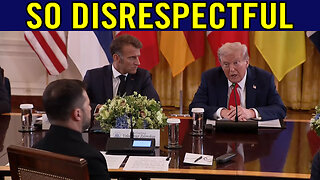Premium Only Content

Fighting Zionist Irgun & Stern gang terrorists: Bill Nash served in Jerusalem for the British Army
Bill Nash talks about serving as a young officer in Palestine before the creation of the Israeli state
In his outstanding analysis of the 1948 war, Israeli historian Ilan Pappe notes that a month after the UN resolution, the Jewish leadership embarked on the ‘ethnic cleansing of Palestine’, beginning with a series of attacks on Arab villages following the vandalisation by some Palestinians of buses and shopping centres in protest at the resolution. The same month the Arab League decided to form an Arab volunteer force to ‘liberate’ Palestine. Known as the Arab Liberation Army (ALA), and consisting of around 5,000 volunteers from Syria, Iraq, Egypt and Jordan, the force began operations in Palestine against Jewish forces in January 1948. As warfare among Jews and Palestinians increased, the Jewish leaders’ plans culminated in a meeting in March 1948 which decided on a ‘Plan D’, the ‘systematic expulsion of the Palestinians from vast areas of the country’. When the British withdrew from Palestine in May, the Jewish Agency declared independence and the regular armies of the Arab states invaded Palestine; brutal fighting ensued between Jewish forces estimated at around 98,000 and Arab forces with around 50,000.
Not all Arab states opposed Israel, however. Transjordan’s King Abdullah, the British-backed monarch still reigning after being installed by London a quarter of a century earlier, entered into a tacit alliance with Israel not to join in any pan-Arab military operations against the Jewish state, and to quietly recognize its existence. In return, Abdullah would be permitted to annex most of the areas allocated to the Arabs under the partition resolution, the lands on the West Bank of the river Jordan. This unwritten agreement, reached in January 1948, resulted in the neutralisation of the Arab world’s most effective fighting force, the British-backed Arab Legion, based in Transjordan and commanded by the British officer, Sir John Bagot Glubb. In May, the same month that the state of Israel was founded, the British ambassador in Transjordan, Sir Alex Kirkbride, wrote to Foreign Secretary Bevin, reporting that ‘there have been negotiations between the Arab Legion and the Hagana [the Jewish paramilitary force] which have been conducted by British officers of the Arab Legion. It is understood that the object of these top secret negotiations is to define the areas of Palestine to be occupied by the two forces’. Bevin replied: ‘I am reluctant to do anything that might prejudice the outcome of these negotiations’.
Bevin’s response was typical of the line the British were now taking on Israel-Palestine. In late May 1948, the British supported the Arab states in opposing a ceasefire resolution at the UN accepted by the Israelis, who had by now annexed a large amount of formerly Palestinian territory and were content to consolidate their gains. The reason for British policy was the hope that Abdullah’s forces would soon capture the West Bank; once it became clear in late May that they had annexed the territory, Britain lifted its opposition to the ceasefire (which later broke down). The formal unification of the two banks of the river Jordan occurred two years later, in April 1950; Britain was one of only two states, along with Yemen, which then recognized the enlargement of Abdullah’s kingdom. British support for ‘Greater Transjordan’, now the Foreign Office’s chosen method for solving the Palestine problem, was intended to make Abdullah, London’s closest ally in the Arab world, the heir to Arab Palestine. If Britain was not able to maintain its own presence in the region, it aimed to do so by proxy through its client state – a strategy typical of postwar British foreign policy.
http://markcurtis.info/2017/03/16/britains-role-in-the-war-in-palestine-1948/
-
 25:57
25:57
DeVory Darkins
1 day ago $12.57 earnedNewsom suffers HUMILIATING SETBACK after FATAL Accident as Trump leads HISTORIC meeting
30.2K123 -
 LIVE
LIVE
FyrBorne
10 hours ago🔴Warzone M&K Sniping: First Impressions of Black Ops 7 Reveal
294 watching -
 8:16
8:16
MattMorseTV
16 hours ago $8.42 earnedTrump’s name just got CLEARED.
70.8K72 -
 2:01:55
2:01:55
MG Show
20 hours agoPresident Trump Multilateral Meeting with European Leaders; Trump Outlines Putin Zelenskyy Meeting
25K19 -
 LIVE
LIVE
DoldrumDan
2 hours agoCHALLENGE RUNNER BOUT DONE WITH ELDEN RING NIGHTREIGN STORY MODE HUGE GAMING
74 watching -
 10:59
10:59
itsSeanDaniel
1 day agoEuropean Leaders INSTANTLY REGRET Disrespecting Trump
19.6K15 -
 16:43
16:43
GritsGG
16 hours agoThey Buffed This AR & It Slaps! Warzone Loadout!
18.1K1 -
 2:05:30
2:05:30
Side Scrollers Podcast
20 hours agoEveryone Hates MrBeast + FBI Spends $140k on Pokemon + All Todays News | Side Scrollers Live
114K11 -
 11:06
11:06
The Pascal Show
14 hours ago $1.47 earned'THEY'RE GETTING DEATH THREATS!' Jake Haro's Lawyer Breaks Silence On Emmanuel Haro's Disappearance!
18.6K2 -
 LIVE
LIVE
Lofi Girl
2 years agoSynthwave Radio 🌌 - beats to chill/game to
306 watching